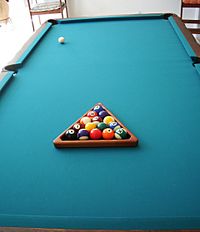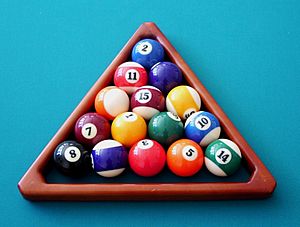Cribbage (pool) facts for kids
Cribbage, also known as cribbage pool, is a fun two-player pool game. It's a bit like the card game of the same name because you score points by matching groups of balls that add up to 15. You play it on a regular pool table. When you pocket a ball, you then need to immediately pocket its "partner" ball. This partner ball is the one that adds up to 15 with the first ball you pocketed.
Each time you successfully pocket a pair of balls that add to 15, it's called a "cribbage." There are seven such pairs you can make. The 15-ball itself counts as an eighth cribbage, but only after all the other balls are gone. The first player to score five cribbages wins the game!
How to Play Cribbage Pool
Setting Up the Game
To start a game of cribbage, you use a standard set of fifteen pool balls. These balls are racked (arranged in a triangle) at one end of the pool table. The very front ball of the triangle, called the apex ball, sits right over the foot spot. The 15-ball is placed right in the middle of the rack.
All the other balls can be placed randomly. However, there's one important rule: no two of the three balls in the corners of the rack can add up to 15. This makes the setup a bit different from many other pool games.
To begin the game, you need to make an open break. This means that when you hit the balls to start, you must either pocket a ball or send at least four balls to hit a rail (the sides of the table). The main goal of the game is to score 5 cribbages out of the 8 possible ones from the 15 balls.
What is a Cribbage?
A cribbage is simply a pair of numbered balls that, when their numbers are added together, make 15. For example, a 1-ball and a 14-ball make a cribbage (1+14=15). A 7-ball and an 8-ball also make a cribbage (7+8=15).
For a cribbage to count, both partner balls must be legally potted (pocketed). This means you can't commit a foul while pocketing them. The only special case is the 15-ball. It becomes a cribbage all by itself, but only after all the other balls on the table have been pocketed.
Basic Rules of Play
For a cribbage to count, you must pocket both balls of the pair one after the other, during the same turn (called an inning).
Here's how it works:
- When you pocket the first ball of a pair, you are "on a cribbage."
- If you don't pocket its partner ball on your very next shot, it's a foul. The ball you pocketed that doesn't have a partner is then spotted (placed back) onto the foot spot. If the foot spot is already taken, the ball is placed as close as possible to it on the line that runs from the foot spot to the foot rail.
If you commit a foul, your turn ends. You don't lose any points you've already scored. The other player then gets to choose: they can either shoot from where the balls are, or they can take cue ball in hand from the kitchen (the area behind the table's head string). If a player commits three fouls in a row, they lose the game!
What if you pocket the 15-ball when there are still other balls on the table? This is not a foul! The 15-ball is simply spotted back onto the table, and play continues without any penalty.
Sometimes, you might pocket more than one ball with a single shot, especially during the break shot. If this happens, you can then try to pocket any of the partner balls for the balls you just pocketed. You must pocket them one after another, in any order you choose. If you complete a cribbage and also pocket other "incidental" balls on the same shot, those extra balls just add to the sequence of cribbages you are trying to make.
If you foul by not pocketing a partner ball when you're trying to complete a cribbage, only the balls that don't have partners are spotted back. Any cribbages you successfully completed before the foul still count towards your score.
Just like in most pool games, there are also rules about hitting the balls and rails. After your cue ball hits an object ball, either an object ball must go into a pocket, or some ball (including the cue ball) must hit a rail. If your cue ball goes into a pocket or jumps off the table (a scratch), the other player gets the cue ball in hand from the kitchen. If all the object balls are also behind the head string in the kitchen, you can ask for the object ball closest to the head string to be moved to the foot spot. If two or more balls are equally close, you can choose which one moves.



